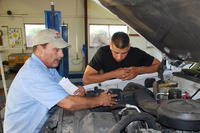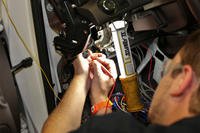If you’ve replaced brake lines on your car, or believe that air has gotten into your brake lines (see Brake Maintenance: 5 Warning Signs for symptoms of this problem), you’ll need to “bleed” your brakes so they’ll work properly again. Basically this means getting any air in your brake lines out, which can be tricky as air that’s trapped in your brake lines will need to be pushed out.
Follow the steps below to “bleed” your brakes. You’ll need the following items:
- Safety glasses (in case of fluid spurts)
- A clear jar (glass or plastic)
- Brake fluid (two quarts if you’re cleaning all four tires)
- Vinyl tube
- 6-point wrenches (5/16” or 3/8” size, depending on your car)
- One person to help you
1. Take the cap off the master cylinder in your engine compartment (see Brake Maintenance: Checking Brake Fluid) and fill the reservoir until it’s about 1/4" under the “maximum” line. Replace the cap but don’t fasten it down.
2. Remove your tires and locate the bleeder screws—there will be one on each tire, on the caliper. They will usually have a cap on them. You may need to oil the screw so it’s loose enough to unscrew.
3. With bleeder screws still fastened tight and the engine off, attach one end of the vinyl hose to the bleeder screw furthest away from the master cylinder (in most cases, the back right wheel). The other end of the vinyl hose will go into the jar. Tighten your wrench around the bleeder screw.
4. Have one person get in the car and “pump” the brakes three or four times, then press down on the brake until it’s as far down as it can go.
5. With the brake pressed down, open the bleeder screw and let the brake fluid run into the jar. The brake pedal should go all the way down during this process. When the pedal hits the floor, tighten the bleeder screw again. Do not take your foot off the pedal until the bleeder screw is tightened. When the screw is tightened, take your foot off the pedal.
6. Repeat steps 4 and 5 until no air or bubbles are coming out through the hose. Add more brake fluid to the master cylinder.
7. Repeat steps 3-6 for the following wheels, in order: left rear wheel, right front wheel, right rear wheel, left front wheel.
8. When finished, refill master cylinder and refasten cylinder cap back on tightly. Make sure all bleeder screws are tight and reattach tires. Be sure to dispose of any excess fluids properly.
Brake Maintenance: 5 Warning Signs
Brake Failure: Emergency Tips
Brake Maintenance: Checking Brake Fluid
Brake Maintenance: Checking and Replacing Your Brake Lines
Brake Maintenance: Inspecting and Replacing Discs and Brake Pads









